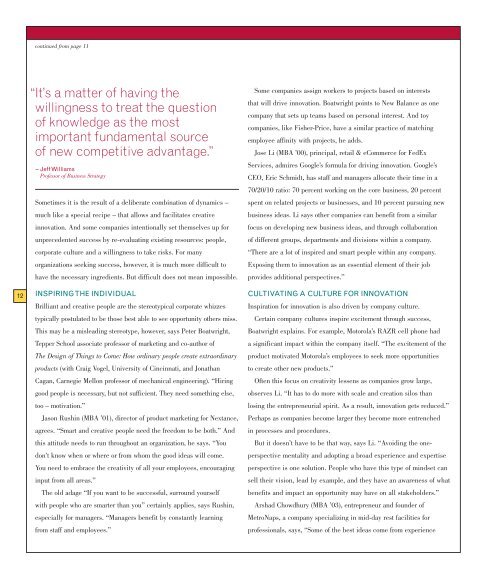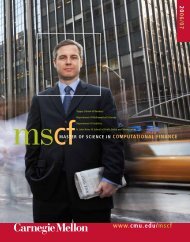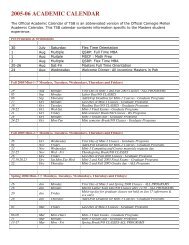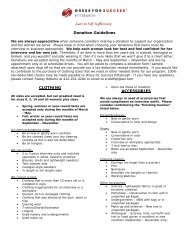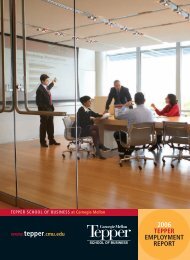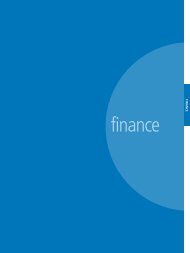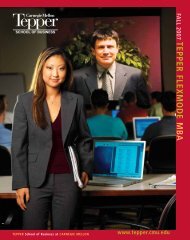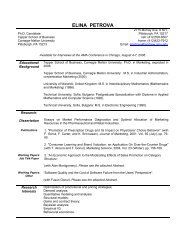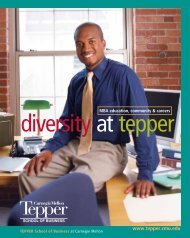tepper - Carnegie Mellon University
tepper - Carnegie Mellon University
tepper - Carnegie Mellon University
Create successful ePaper yourself
Turn your PDF publications into a flip-book with our unique Google optimized e-Paper software.
continued from page 11<br />
12<br />
“It’s a matter of having the<br />
willingness to treat the question<br />
of knowledge as the most<br />
important fundamental source<br />
of new competitive advantage.”<br />
– JeffWilliams<br />
Professor of Business Strategy<br />
Sometimes it is the result of a deliberate combination of dynamics –<br />
much like a special recipe – that allows and facilitates creative<br />
innovation. And some companies intentionally set themselves up for<br />
unprecedented success by re-evaluating existing resources: people,<br />
corporate culture and a willingness to take risks. For many<br />
organizations seeking success, however, it is much more difficult to<br />
have the necessary ingredients. But difficult does not mean impossible.<br />
INSPIRINGTHE INDIVIDUAL<br />
Brilliant and creative people are the stereotypical corporate whizzes<br />
typically postulated to be those best able to see opportunity others miss.<br />
This may be a misleading stereotype, however, says Peter Boatwright,<br />
Tepper School associate professor of marketing and co-author of<br />
The Design of Things to Come: How ordinary people create extraordinary<br />
products (with Craig Vogel, <strong>University</strong> of Cincinnati, and Jonathan<br />
Cagan, <strong>Carnegie</strong> <strong>Mellon</strong> professor of mechanical engineering). “Hiring<br />
good people is necessary, but not sufficient. They need something else,<br />
too – motivation.”<br />
Jason Rushin (MBA ’01), director of product marketing for Nextance,<br />
agrees. “Smart and creative people need the freedom to be both.” And<br />
this attitude needs to run throughout an organization, he says. “You<br />
don’t know when or where or from whom the good ideas will come.<br />
You need to embrace the creativity of all your employees, encouraging<br />
input from all areas.”<br />
The old adage “If you want to be successful, surround yourself<br />
with people who are smarter than you” certainly applies, says Rushin,<br />
especially for managers. “Managers benefit by constantly learning<br />
from staff and employees.”<br />
Some companies assign workers to projects based on interests<br />
that will drive innovation. Boatwright points to New Balance as one<br />
company that sets up teams based on personal interest. And toy<br />
companies, like Fisher-Price, have a similar practice of matching<br />
employee affinity with projects, he adds.<br />
Jose Li (MBA ’00), principal, retail & eCommerce for FedEx<br />
Services, admires Google’s formula for driving innovation. Google’s<br />
CEO, Eric Schmidt, has staff and managers allocate their time in a<br />
70/20/10 ratio: 70 percent working on the core business, 20 percent<br />
spent on related projects or businesses, and 10 percent pursuing new<br />
business ideas. Li says other companies can benefit from a similar<br />
focus on developing new business ideas, and through collaboration<br />
of different groups, departments and divisions within a company.<br />
“There are a lot of inspired and smart people within any company.<br />
Exposing them to innovation as an essential element of their job<br />
provides additional perspectives.”<br />
CULTIVATING A CULTURE FOR INNOVATION<br />
Inspiration for innovation is also driven by company culture.<br />
Certain company cultures inspire excitement through success,<br />
Boatwright explains. For example, Motorola’s RAZR cell phone had<br />
a significant impact within the company itself. “The excitement of the<br />
product motivated Motorola’s employees to seek more opportunities<br />
to create other new products.”<br />
Often this focus on creativity lessens as companies grow large,<br />
observes Li. “It has to do more with scale and creation silos than<br />
losing the entrepreneurial spirit. As a result, innovation gets reduced.”<br />
Perhaps as companies become larger they become more entrenched<br />
in processes and procedures.<br />
But it doesn’t have to be that way, says Li. “Avoiding the oneperspective<br />
mentality and adopting a broad experience and expertise<br />
perspective is one solution. People who have this type of mindset can<br />
sell their vision, lead by example, and they have an awareness of what<br />
benefits and impact an opportunity may have on all stakeholders.”<br />
Arshad Chowdhury (MBA ’03), entrepreneur and founder of<br />
MetroNaps, a company specializing in mid-day rest facilities for<br />
professionals, says, “Some of the best ideas come from experience


